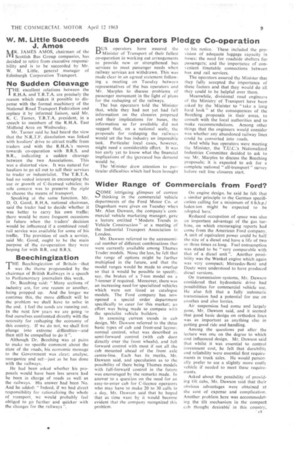Wider Range of Commercials from Ford?
Page 11

If you've noticed an error in this article please click here to report it so we can fix it.
SOME intriguing glimpses of current thinking in the commercial vehicle departments of the Ford Motor Co. at Dagenham were given on Tuesday when Mr. Alan Dawson, the company's commercial vehicle marketing manager, gave a lecture entitled " Modern Trends in Vehicle Construction" at a meeting of the Industrial Transport Association in London. Mr. Dawson referred to the astronomical number of different combinations that were currently available among Thames Trader models. None the less, he felt that the range of options might be further multiplied in the future, and that the model ranges would be made to overlap so that it would be possible to specify, say, the brakes of a 7-ton model on a 5-tonner if required. Moreover, there was an increasing need for specialized vehicles which were not listed as catalogue models. The Ford company has now opened a special order department specifically to cater for this market; an effort was being made to compete with the specialist vehicle builders. In assessing current trends in cab design, Mr. Dawson referred to the three basic types of cab and front-end layout: normal control, what was described as semi-forward control (with cab door directly over the front wheels), and full forward control with most if not all the cab mounted ahead of the front axle centre-line. Each has its merits. Mr. Dawson said, and speculation as to the possibility of there being Thames models with full-forward control in the future was encouraged by the remarks made. In answer to a question on the need for an easy-to-enter cab for C-licence operators who may have to make 20 to 30 calls in .a day, Mr. Dawson said that he hoped that as time went by it would become evident that the company recognized this problem. On engine design, he said he felt that a similar principle to the German specification calling for a minimum Of 6 b.h.p./ laden ton might be expected to be adopted here: Reduced occupation of space was also an important advantage of the gas turbine, on which encouraging reports had come from the American Ford company. A unit of equivalent power could be half the size of a diesel and have a life of two or three times as long. Fuel consumption was stated to he "very comparable with that of a diesel unit ". Another possibility was the Wankel engine which again was very compact; Mercedes-Beni and Deutz were understood to have produced diesel versions.
On transmission-systems, Mr. Dawson congidered that hydrostatic drive had possibilities for commercial vehicle use. He also felt that a fully automatic transmission had a potential for use on coaches and also lorries.
Air suspension had come and largely gone, Mr. Dawson said, and it seemed that good basic design on orthodox lines was as important as anything else in getting good ride and handling. Among the questions put after the lecture was one on the degree to which cost influenced design. Mr. Dawson said that whilst it was essential to control investment cost, he felt that durability and reliability were essential first require. runts in truck sales. He would person. ally prefer to see a slightly more costly vehicle if needed to meet these requirements.
Asked about the possibility of providing tilt cabs, M. Dawson said that their obvious advantages were obtained at the cost of expense and complication. Another problem here was accommodating the tilt mechanism in the compact cab thought desirable' in this country.








































































































